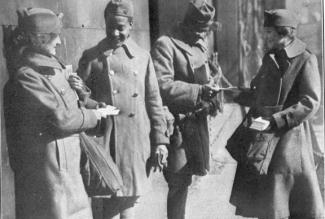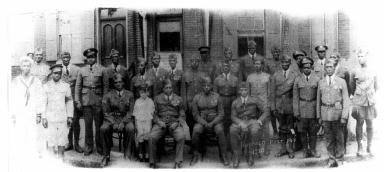|
|
A. Dennee
Bibb
Community Hero
|
aCentury
ofChange
|
|
the 20th Century
|
|
This
brief biographical sketch is meant to shed light on one of Harrisburg's
hitherto lesser-known community heroes. Alexander Dennee Bibb is the
subject of a proposed Pennsylvania Historical and Museum Commission
historical marker, at the suggestion of Harrisburg historian Calobe
Jackson, Jr. and Lincoln University trustee Nathan Waters, Esq.
Calobe Jackson, Jr. supplied the biographical information and the
photograph.
|
|
Born in Harrisburg in 1887,
Alexander Dennee Bibb grew up in a growing and thriving African American
community during America's Gilded Age. The sense of prosperity and promise of
this time offered many opportunities to all American citizens, including its
politically and economically marginalized African American population. One of
the most fervent promises, and the one that would be the most enduring, was a
dedication to education as a means to self improvement. A. Dennee Bibb
attended local schools, which, under the watchful eye of such pioneering
African American educators as William Howard Day and John Powell Scott, began
offering opportunities to African American students on par with those offered
to white students.
Graduating from Central High
School in 1907, Bibb was encouraged to continue his education on a higher
level. His family boasted of many local community leaders, including his
maternal grandfather William Dennee, a well-known barber whose influence led
to his appointment as the first African American tax collector in Harrisburg's
old Eighth Ward. Bibb's family was related to the Marshall and Layton
families; his aunt married the Rev. William Marshall, a well-known local
school teacher and pastor of Harris A.M.E. Zion church. It is no wonder
then, with this rich mix of heritage and family tradition, that Bibb chose
Lincoln University, which was known "to provide a higher education in the
arts and sciences to male youths of African descent," to continue
his education.
|
|
It was while Bibb was a student
at Lincoln that he was inspired, no doubt by his long family history of
service to the community, that he wrote the college's alma mater. Bibb
graduated in 1913, leaving the school, but his composition remains as an
enduring legacy for all Lincoln University students and alumni.
Harrisburg historian Calobe Jackson, Jr., notes, "Learning the words of
this Alma Mater has been a tradition for students of Lincoln University. The song is sung at graduations, athletic events and campus affairs. Alumni
members often mention 'Dear Old Orange And Blue,' in their correspondence. Students from around the world and of all nationalities recognize the words and recall their golden days at the
college."
After graduation from Lincoln,
A. Dennee Bibb returned to Harrisburg where he was appointed to the city
police force. Political and cultural clashes overseas, however, were
causing a chain of events that not only threatened European stability, but
would eventually drag America from her post-golden-age revelry into the storm
of a world war. Following the lead of hundreds of thousands of American
young men, including tens of thousands of African American men, Bibb entered the army
in 1917 as America prepared to come to the aid of her European allies.
Although about 350,000 African American males would serve in segregated units
during the war, most were part of labor and support battalions, and only a few
thousand actually saw combat. Bibb was one of these men.
Enlisting
in the 351st Field Artillery unit, an all African American regiment, Bibb saw
action in France in 1918. The 351st Field Artillery was part of the 92nd
Infantry Division, which was organized November 29, 1917, its enlisted ranks composed
entirely from the first African American enlistees. Although the African
American volunteers were placed in segregated units, the War Department had
not made arrangements to place the entire division in a separate camp.
As a result, the division was split up among seven camps across the country
for training and organization prior to deployment. Bibb found himself,
with the other members of his artillery unit, in Camp Meade, Annapolis
Junction, Maryland.
|
Alma Mater
Dear Lincoln, Dear Lincoln
Thy Sons will e're be true!
The golden hours we've spent beneath
The dear old Orange and Blue
Will live for e're in memory,
As guiding starts through life;
For thee our Alma Mater dear,
We'll rise in our might.
For we love every inch of thy sacred soil
Every tree on thy campus green:
And for thee with our might
We will ever toil
That thou mightest be supreme.
We'll raise thy standard to the sky
Midst glory and honor to fly;
And constant and true.
We will live for thee anew
Our Dear Orange and Blue
Hail! Hail! Lincoln!
A. Dennee Bibb, '13
source: Lincoln
U. Class Reunion Site
|
 The
photograph at left is from Emmet J. Scott's American Negro in the World War
(1919). The original caption was "The Salvation Army Draws No Color
Line. Soldiers of the 351st Field Artillery are receiving candy from Salvation
Army lassies on their return to New York." (Chapter VII, photo section
between pages 96 and 97) The
photograph at left is from Emmet J. Scott's American Negro in the World War
(1919). The original caption was "The Salvation Army Draws No Color
Line. Soldiers of the 351st Field Artillery are receiving candy from Salvation
Army lassies on their return to New York." (Chapter VII, photo section
between pages 96 and 97)
The War Department used only
better educated men for artillery regiments. Emmett J. Scott, in his
book American Negro in the World War, wrote:
It was doubted whether or not
an artillery brigade made up of Negro soldiers could be developed and
sufficiently trained in the technique of artillery to make an effective
fighting artillery unit. Men were needed for this branch of the service who
were educated and who could be depended upon to know fractions and be able to
read scales, deflections, and other technical details. In the ordinary run of
the enlistment, the draft did not furnish enough men qualified along these
lines to build up the artillery regiments, and it therefore became necessary
for the officers of the artillery brigade to make special canvasses to secure
a sufficient number of qualified men. In this work, voluntary enlistments were
called for. In the course of time enough men were enlisted to make up the
Artillery Brigade. Tuskegee Institute furnished a group of students.
Baltimore, Pittsburg and other cities furnished men from the high schools and
other institutions. Through this special canvass the great bulk of the
artillery troops was secured.
The artillerymen reached
France in June 1918 and went through an additional training period lasting
into early August in their base at Montmorrillon. They eventually
supported the division through the final assaults on German sectors at the end
of the war. Though it distinguished itself in the vicious trench
warfare, the division suffered heavy casualties, including over 600 victims of
the feared mustard gas. A. Dennee Bibb was one of these
casualties. Although he survived the attack and the war, the effects of
being wounded by the gas stayed with him the rest of his life.
Following the war, Bibb resumed his job as a policeman in Harrisburg.
It was not long, however, before his desire for more education led him to
enroll at Dickinson Law School. His experience with law enforcement,
coupled with his family's deep respect for education--an education that had
already allowed him to serve his country as an efficient artilleryman--seemed
to be leading him to a law career. This dream was not to be realized,
though. The lingering effects of the gas attack contributed to his ill
health, and his studies were seriously affected. Bibb was forced to drop
his study of the law, but he retained his interest in, and dedication to, his
community. Active in the Buffalo Post 148, Veterans of Foreign Wars,
Bibb shows up in a group photograph of post members, assembled outside of the
building, proudly wearing his original artilleryman's uniform. He would
later assume command of that post, until his death on May 3, 1934. He
also served as an enumerator for the 1930 census, and was so well respected
that he was elected committeeman in the city's Seventh Ward posthumously.
Sources:
-
Correspondence, Calobe Jackson, Jr. to Afrolumens, December 19,
20, 21, 29, 2003.
-
Barton, Michael and Jessica Dorman. Harrisburg's Old Eighth Ward
(Charleston, SC, Arcadia Publishing, 2002).
-
Boyd's Harrisburg and Steelton Directory, 1887.
-
Boyd's Directory of Harrisburg and Steelton, 1919.
-
Boyd's Directory of Harrisburg and Steelton, 1930.
-
Scott, Emmet J. Scott's Official History of The American Negro
in the World War (1919).
|
 This
photograph, dated 1930, shows the members of VFW Buffalo Post 148, gathered
for a group portrait outside of the old post headquarters. Named in
honor of the famed Buffalo Soldiers, who saw service in the West following the
Civil War, the post was located at 664 Boas Street and was commanded by George
Richards at the time of this photograph. Please click the thumbnail
for a larger image. This
photograph, dated 1930, shows the members of VFW Buffalo Post 148, gathered
for a group portrait outside of the old post headquarters. Named in
honor of the famed Buffalo Soldiers, who saw service in the West following the
Civil War, the post was located at 664 Boas Street and was commanded by George
Richards at the time of this photograph. Please click the thumbnail
for a larger image.
A. Dennee Bibb is standing at the far right,
wearing his WWI uniform with original issue leggings. When Bibb died, in
1934, he was commander of Buffalo Post 148.
Calobe Jackson notes about this picture,
"Dennee Bibb and Thomas Beckwith were both in the 351st F. A. in WW1.
Barbara [Barksdale] wrote the great article about
Beckwith and Legion Post 479. Beckwith may also have been a member of VFW
Post 148, and may be on the 1930 picture. Speaking of the picture, Robert
Williams, son of William Williams
and brother of Clarence Williams is on the picture. Robert served in the 10th
Calvary and played baseball with the Harrisburg
Giants under Colonel Strothers."
|
Afrolumens
Home Page | Enslavement
| Underground Railroad | 19th Century
| 20th Century
Original
material on this page copyright 2023 Afrolumens Project
|
